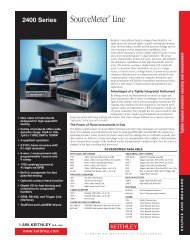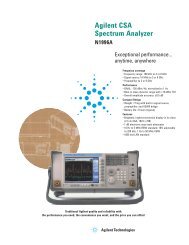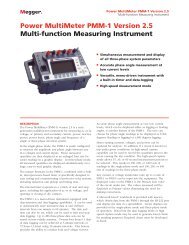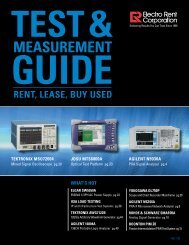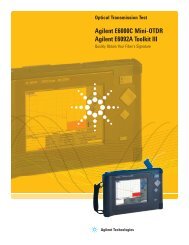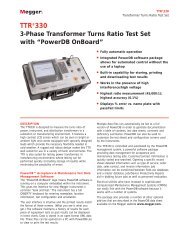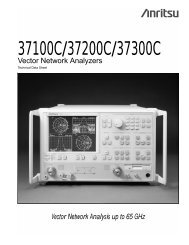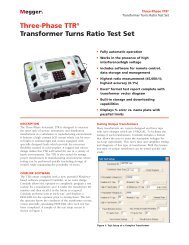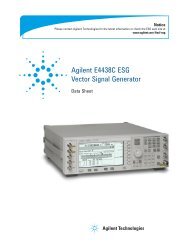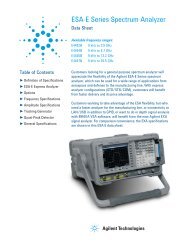Agilent E5052B Signal Source Analyzer 10 MHz to 7 GHz, 26.5 GHz ...
Agilent E5052B Signal Source Analyzer 10 MHz to 7 GHz, 26.5 GHz ...
Agilent E5052B Signal Source Analyzer 10 MHz to 7 GHz, 26.5 GHz ...
- No tags were found...
Create successful ePaper yourself
Turn your PDF publications into a flip-book with our unique Google optimized e-Paper software.
Display FuntionsTable 9-1. Display functions (windows and traces)DescriptionMeasurement windowsUser defi nable windowTrace functionsData tracesTrace mathTitleAu<strong>to</strong> scaleStatisticsMarker functionsData markersMarker searchMarker-<strong>to</strong>Searching rangeTrackingGeneral characteristicsUp <strong>to</strong> 6 windows, and 1 user defi nable window8 data traces and 8 memory tracesDisplay current measurement data and/or memory dataAddition, subtraction, multiplication, or division of trace dataAdd cus<strong>to</strong>mized title <strong>to</strong> each measurement windowTitles are printed on hard copies of displayed measurements.Au<strong>to</strong>matically selects scale resolution and reference value <strong>to</strong> vertically center the trace.Calculates and displays mean, standard deviation, and peak-<strong>to</strong>-peak deviation of the trace.<strong>10</strong> independent markers per trace.Reference marker available for “delta marker” operation.Maximum value, minimum value, peak, peak-left, peak-right, target, target-left,target-right, multi-peak and band markers with user-defi nable bandwidth value.Set, start, s<strong>to</strong>p, center <strong>to</strong> active marker stimulus value.Set reference <strong>to</strong> active marker response value.User defi nablePerforms marker search continuously or on-demand.Data Processing CapabilitiesTable 9-2. Data processing capabilitiesDescriptionGraphical user interfaceLimit-line testData s<strong>to</strong>rageInternal removable HDDFile sharingScreen hard copyAu<strong>to</strong>mationBuilt-in VBA ®Controlling via GPIB or USBControlling via USBTMCLANGeneral characteristicsThe analyzer employs a graphical user interface based on Windows XP ® open OS.There are three ways <strong>to</strong> operate the instrument manually; you can use a hard keyinterface, a <strong>to</strong>uch-screen interface, or a mouse interface.Defi ne the test limit that appears on the display for pass/fail testing.Defi ned limits may be any combination of horizontal or sloping lines and discrete data points.S<strong>to</strong>re and recall instrument states and trace data on 5 GB (user area) internal removablehard disk drive. Instrument states include all control settings and memory trace data.Files on user disk drive (F:) can be accessed from an external Windows ® PCthrough LAN or USB (USB-TMC)Print-outs of instrument data are directly produced on a printer via USB.Applications can be developed in a built-in VBA ® (Visual Basic for Applications) language.The GPIB interface operates with IEEE488.2 and SCPI pro<strong>to</strong>cols. The instrument can be controlled bya GPIB external controller. The instrument can control external devices using a USB/GPIB interface.The USB interface operates with USBTMC and SCPI pro<strong>to</strong>cols. The instrument can be controlled byan external PC using the USB interface with a USB cable.(<strong>10</strong>/<strong>10</strong>0 base-T) Telnet, SICL-LANOptional Application SoftwareTable 9-3. E5001A SSA-J precision clock jitter analysis softwareDescriptionGeneral characteristicsMeasurement functionsRJ (random jitter), PJ (periodic jitter) frequency, PJ decomposition with au<strong>to</strong>-trend correctionMeasurement parametersRJ: rms, PJ: frequency, rms, p-p, d-d,TJ (<strong>to</strong>tal jitter): p-p, jitter trend (phase deviation waveform), jitter his<strong>to</strong>gramJitter spectrum analysis range 1 Hz <strong>to</strong> <strong>10</strong>0 <strong>MHz</strong> (<strong>E5052B</strong>), <strong>10</strong> Hz <strong>to</strong> <strong>10</strong>0 <strong>MHz</strong> (<strong>E5052B</strong> Option 011)15




